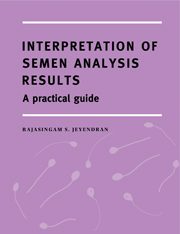Book contents
- Frontmatter
- Contents
- Preface
- Introduction
- Hypotheses on fertile ejaculate identification
- Male reproductive system background
- Semen analysis interpretation
- ROUTINE SEMEN ANALYSIS
- SPECIALIZED SEMEN ANALYSIS
- The logical sequence of routine and specialized semen analysis
- Semen component point-of-origin
- Conclusion
- Standard semen variable reference values for clinical interpretation and diagnosis (Table 1)
- Specialized semen test reference values for clinical interpretation and diagnosis (Table 2)
- Spermatozoa biochemical analysis and seminal plasma chemical analysis reference values for clinical interpretation and diagnosis (Table 3)
- Glossary
- Suggested additional reading
- Index
Introduction
Published online by Cambridge University Press: 05 August 2016
- Frontmatter
- Contents
- Preface
- Introduction
- Hypotheses on fertile ejaculate identification
- Male reproductive system background
- Semen analysis interpretation
- ROUTINE SEMEN ANALYSIS
- SPECIALIZED SEMEN ANALYSIS
- The logical sequence of routine and specialized semen analysis
- Semen component point-of-origin
- Conclusion
- Standard semen variable reference values for clinical interpretation and diagnosis (Table 1)
- Specialized semen test reference values for clinical interpretation and diagnosis (Table 2)
- Spermatozoa biochemical analysis and seminal plasma chemical analysis reference values for clinical interpretation and diagnosis (Table 3)
- Glossary
- Suggested additional reading
- Index
Summary
Male infertility has been estimated as the primary or contributory factor in more than 40% of infertile couples. Ejaculate analysis is a major tool in male fertility evaluation. Female fertility analysis, being a relatively expensive and complicated process, makes early semen analysis diagnostically appealing. In addition, semen analyses are routinely performed before and/or after cryopreservation, assisted reproductive techniques - such as intrauterine insemination (IUI) and in vitro fertilization (IVF) - vasectomy, vasovasostomy, and for the detection of toxicant exposure to the male reproductive tract.
Over the last few decades, the in-depth study of reproductive function has resulted in many specialties and subspecialties, particularly in andrology. If sperm are freely present in the ejaculate, these specialties help process the sperm for insemination, IVF or intracytoplasmic sperm injection (ICSI). Other subspecialties aspirate the sperm from the reproductive tract (TESE - testicular sperm extraction; MESA: microepididymal sperm aspiration) for ICSI. Rather than conduct an interpretation of semen analysis and thereby correct any problems that might be identified, or first perform fertility enhancing procedures to the ejaculate, many specialists simply refer their patients directly to IVF or ICSI procedure. Although more than 300 laboratories in the United States perform IVF, they remain insufficient to handle every case of male infertility.
Male fertility is dependent upon sperm quantity and quality. Ideally, the fertilizing capacity may be directly appraised by sperm incubation with oocytes under natural reproductive or controlled laboratory conditions. Unfortunately, such a procedure is difficult, if not impossible, for routine semen analysis evaluations.
As a practical and viable substitute, several sperm assays have been developed to indirectly infer sperm fertilizing capacity. Standard attributes routinely reported during such diagnostic evaluation include sperm concentration, percent sperm motility, and percent normal sperm morphology. Since large variations may occur even between consecutive ejaculates from the same individual, the fertility potential of the individual under evaluation remains problematic. For example, sperm concentration between ejaculates sampled from the same patient can vary as much as two to threefold, or more. Consequently, only if one or many attributes exhibit extremely poor values can a given result prove deterministic. The interpretation of semen analysis results, therefore, inevitably plays a vital role in the treatment of infertile couples.
- Type
- Chapter
- Information
- Interpretation of Semen Analysis ResultsA Practical Guide, pp. 1 - 4Publisher: Cambridge University PressPrint publication year: 2000



